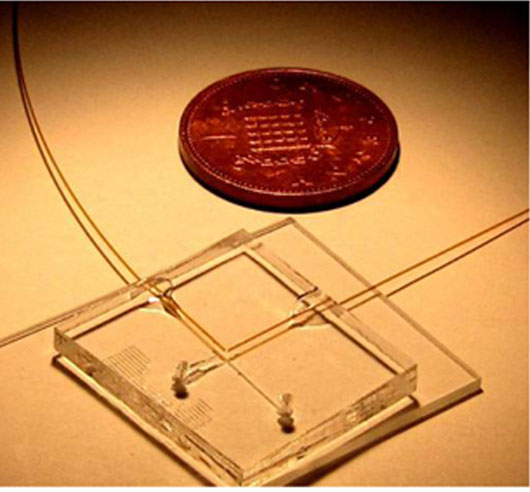Breakthrough calls time on bootleg booze

A new technique for detecting dangerous fake whisky, and other spirits, has been developed by researchers at the University of St Andrews.
Using a laser, the St Andrews scientists can now carry out detailed analysis of a spirit sample no bigger than a teardrop and can even confirm whether it is toxic or not. It’s hoped the testing breakthrough will help cut the worldwide toll of death and serious injury arising from consumption of fake and adulterated spirits.
This technique could see portable detectors created which would allow people to test their drinks when out and about.
Writing in the Journal of Raman Spectroscopy, Praveen Ashok, Bavishna Balagopal and Professor Kishan Dholakia of the School of Physics and Astronomy at the University, reveal how they can place a “teardrop” of whisky on a transparent “plastic chip, no bigger than a credit card”.
Light is then delivered to, and collected from, the liquor sample using optical fibres – each has the dimensions of a human hair – to diagnose the sample by a collection of light scattered from it.
Previous work by the team showed they were able to investigate and discriminate single malt Scotch whiskies based on brand, age and even which cask had been used.
The method exploits both the fluorescence of the whisky and also what is known as the Raman signature of the whisky – this is when light scatters but shifts slightly in energy due to interaction with the molecules in the sample. The latest study now shows this elegant technique is highly sensitive and can be used to detect trace toxic additives such as methanol at concentrations of less than 1 per cent by volume.
Researcher Praveen Ashok said: “Sadly, many people lose their lives each year to bootleg drinks and our hope is to see this powerful, simple technology used to alleviate this serious issue”.
Researcher Bavishna Balagopal said: “It is exciting to see the surprising and powerful ways modern photonics can help people, particularly in developing countries.”
Professor Kishan Dholakia added: “This technology not only can ensure a high degree of quality control for the international drinks industry but could also lead to portable sensors to ensure everyone can enjoy a drink, safe in the knowledge that no toxic additives are present.”
Toxic liquor claims hundreds of lives all around the world every year. Especially in Afro-Asian countries, where illegal moonshine liquors are common, methanol is often intentionally added to increase the effect of the liquor.
The researchers are hoping to interest industry with their technology which is patented.
Note to Editors
The research is published in the Journal of Raman Spectroscopy (DOI: 10.1002/jrs.4301)
For image please contact the press office.
Professor Dholakia is available on [email protected] / 01334 463814
Praveen Ashok can be contacted at [email protected] / 01334 461656.
Issued by the Press Office, University of St Andrews
Contact Fiona MacLeod on 01334 462108 / 0771 414 0559.
Ref: (whiskylight 17/05/13)
View the University’s latest news at www.st-andrews.ac.uk/news
Category Research